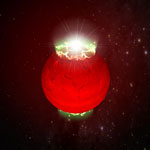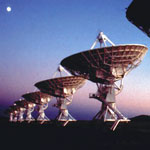Gregg Hallinan
KISS Cultivates Discussion to Grow Big Ideas
Caltech Assistant Professor of Astronomy Gregg Hallinan uses radio astronomy observations to search for potentially habitable planets orbiting stars other than our Sun. He describes himself as “a space weatherman,” chasing radio waves from distant planets with magnetic fields. Every so often, the Sun acts up, emitting coronal mass ejections, which are dangerous bubbles of ionized gas. “They slam into the Earth, and (happily for us) the Earth’s magnetic field shields us from that activity. When that happens actually is when you see aurorae. So the beautiful aurorae are a signature that the Earth is experiencing a geomagnetic storm. Space weather.” These interactions produce a characteristic pattern of radio waves, that — in theory — could be detected from a great distance, flagging Earth as a planet possessing a magnetic field.

Hallinan studies the ‘flare stars’ that possess hot and dense coronae and produce massive magnetic flares, orders of magnitude more energetic than any produced by the Sun. The particular focus is on detecting the radio bursts associated with the largest flares. Hallinan uses the technique of Very Long Baseline Interferometry (VLBI) to directly image their coronae, connecting telescopes across the globe to produce images with a resolution 1000 times better than that of the Hubble Space Telescope.
It stands to reason, Hallinan says, that exoplanets with magnetic fields could be identified in the same way: by looking for the telltale signature of a planetary magnetic field as it encounters stellar storms of its own. “What we hope to see is something very like this, where we see this big radio burst from the star and then a day or two later, out pops this planetary source. And what’s really amazing is that just by measuring the frequency of that radio emission, we can measure exactly how strong the magnetic fields are for that planet. So it’s a really powerful technique.”
“
KISS is really a unique environment. It brings together not just people in your own field, but from multidisciplinary fields.
”
Hallinan’s observations are breaking exciting new ground, because the presence of a magnetic field may indicate that certain exoplanets can weather the worst storms their stars send their way. “Detecting those radio waves will provide the first window on whether or not those planets can host life.” But to see the effects of distant magnetic storms, we have to be looking at just the right time to catch them in the act, and that got Hallinan thinking about new ways to make radio observations. “I realized that the old technique of pointing a big telescope in some direction for a few hours at a time just wouldn’t work. We’d need to figure out a way to monitor all of these planets simultaneously.”

Hallinan is conducting some of the deepest radio searches for exoplanets yet attempted, using low frequency radio telescopes like the Giant Metrewave Radio Telescope (GMRT) in India and the Long Wavelength Array (LWA) in New Mexico. Another ongoing project involves the study of magnetic activity in brown dwarfs. He is using the Jansky Very Large Array (VLA) and the Keck telescopes to study these auroral emissions, which are a powerful diagnostic of magnetic activity in brown dwarfs.
Thinking Outside the Box
To explore this new possibility, Hallinan and colleagues organized a KISS workshop in 2013 focusing on planetary magnetic fields and habitability. “I wanted to make sure that we were on the right path, so we all came together and began to discuss what are the signatures of magnetic fields? When the Earth experiences an aurora for example, that’s because we have magnetic fields. Is there a way we can detect that? We got in a room, bouncing off ideas between astronomers who look at exoplanets and planetary scientists who focus on the Earth and Jupiter, and also engineers at JPL, who are used to thinking outside the box.”
“
The way KISS is designed, you try to break down the seniority barriers.
”
Hallinan is now the Principal Investigator of the Owens Valley Long Wavelength Array, a collection of antennas spread out across the desert, scanning every star out to 80 light-years away every 24 hours. “We are monitoring 4,000 extrasolar systems, looking for the radio burst produced by stars when they produce those coronal mass ejections and then by the planets when they produce the aurorae.” A recent upgrade, scheduled to go into operation next year, will further increase their sensitivity by a factor of ten.

Hallinan's research involves detecting variable radio emission from stars, brown dwarfs and planet. He has commenced programs to systematically search for variability in Jansky VLA data in an effort to detect new classes of transient radio sources. In addition, he is leading efforts to build a Long Wavelength Array (LWA) station at the Owens Valley Radio Observatory that will instantaneously image the entire viewable sky every few seconds to search for radio transients.
Wacky Idea to Cutting Edge Science
When it comes to really big ideas, says Hallinan, KISS is a breeding ground. “I came away realizing that for germinating new ideas, this was the way to do it. It definitely has had a big influence.” For example, when the subject of using radio waves to detecting Earth-sized exoplanets came up at the workshop, a “wacky idea” captured his attention. “We realized that the far side of the Moon is a particularly radio-quiet area because it’s shielded away from the Earth’s terrestrial radio emission. And we also realized that the far side of the moon is dotted with craters, and those craters are caused by meteors impacting the lunar surface,” leaving behind a nice parabolic dish. “We found some craters on that surface that are maybe two kilometers across that in the future, we could send a rover to the surface to actually put wire across that crater. And suddenly you’ve made the biggest radio telescope ever built. And that radio telescope will be the perfect instrument to find Earth-like radio waves. That’s an example of an idea that came from KISS that I’m very excited about.”

Fostering Future Leaders
Thanks to the welcoming attitude and innovative style cultivated at KISS, that excitement is shared by researchers at all stages in their careers. “The way KISS is designed, you try to break down the seniority barriers,” says Hallinan, and for good reason. “When you’re working on a topic that has a future space application, it may take 20 years or more for that application to be realized. And you really need to engage the graduate students and the postdocs into that idea in order for them to be the leaders that take that idea to its full fruition.”
“
When you’re working on a topic that has a future space application, it may take 20 years or more for that application to be realized. And you really need to engage the graduate students and the postdocs into that idea in order for them to be the leaders that take that idea to its full fruition.
”
Gregg Hallinan
That open invitation to get involved and brainstorm new ideas speaks to the sense of discovery that Hallinan finds in his own research. “This is a new adventure. We’ve never found any radio waves from other planets and it’s kind of like a voyage of discovery,” he says. “I love what I do because it’s never been done before.”